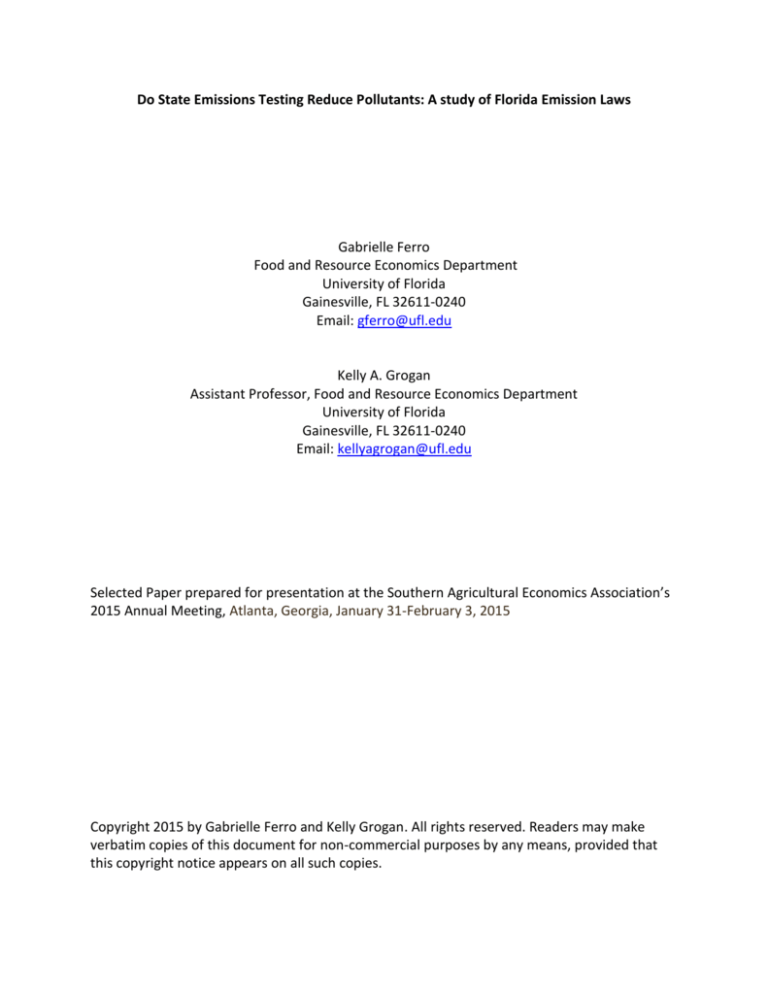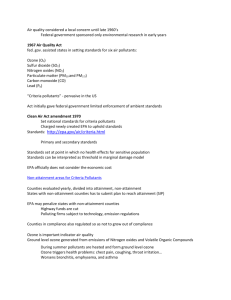
Do State Emissions Testing Reduce Pollutants: A study of Florida Emission Laws
Gabrielle Ferro
Food and Resource Economics Department
University of Florida
Gainesville, FL 32611-0240
Email: gferro@ufl.edu
Kelly A. Grogan
Assistant Professor, Food and Resource Economics Department
University of Florida
Gainesville, FL 32611-0240
Email: kellyagrogan@ufl.edu
Selected Paper prepared for presentation at the Southern Agricultural Economics Association’s
2015 Annual Meeting, Atlanta, Georgia, January 31-February 3, 2015
Copyright 2015 by Gabrielle Ferro and Kelly Grogan. All rights reserved. Readers may make
verbatim copies of this document for non-commercial purposes by any means, provided that
this copyright notice appears on all such copies.
Not every state in the United States has a car emission program in place to combat
pollution. In the 1990’s Florida had a Motor Vehicle program in place in order to comply with
Environmental Protection Agency requirements. This research looks to identify whether
elimination of the MVIP program in the state of Florida led to an increase in Ozone Pollution in
the six non-attainment counties. Performing difference in difference with matching provides
analysis of the increase, decrease or unchanged pollution in the six non-attainment counties.
Previous literature has not looked at what has happened after the elimination of this program.
Introduction
The Clean Air Act (CAA) of 1970 was a federal law that regulates air emission and
created National Ambient Air Quality Standards (NAAQS). NAAQS was used to determine
counties that were to be considered non-attainment and attainment in terms of level of
pollutants (EPA 2013). The CAA looks at six pollutant levels to determine attainment or nonattainment status: Ozone, Particulate Matter, Carbon Monoxide, Nitrogen Oxides, Sulfur
Dioxide and Lead. This paper looks at the change in Ozone levels following the elimination of
the Florida Motor Vehicle Inspection Program (MVIP).
In 1988 in response to the CAA Florida created the MVIP. The total time the program
was in effect was 9 years and was eliminated after the non-attainment counties reached
maintenance status, as defined by the EPA. On July 1, 2000 the state of Florida eliminated auto
emission testing for vehicles registered in the state. In 1992, 6 out of 67 counties were listed as
non-attainment status for 1-Hr Ozone (EPA 2012a). The program was active in three areas of
the state. Broward, Duval, Hillsborough, Miami-Dade, Broward and Palm Beach county were
the counties that reached non-attainment status in 1992 and by 1996 had been placed in the
maintenance category. There were no non-attainment counties after 1996 in the State of
Florida, until early in the 2000’s. The program was discontinued due to outdated technology
that would have needed to be updated to continue to be effective in controlling emissions
(State of Florida). Given this information it is important to ask if the elimination of the MVIP in
Florida resulted in increased pollution in the six counties in which is was active in. This research
will look to determine the impact that ending this program had on Ozone levels in the six
counties listed as non-attainment in 1991.
History of the CAA
The CAA was put into place in 1970 by Federal Law to regulate air emissions from
sources, both stationary and mobile. NAAQS were established through this act and every state
was required to achieve certain levels starting in 1975. The pollutants that were regulated
were those that had public and welfare risks associated with them. Increased Ozone can make
it difficult to breath and damage the airways, leading to increased absences from work and
school and increased healthcare costs (EPA 2012b). Other pollutants can cause premature
death, aggravation of asthma and other pre-existing conditions, and heart problems. The
creation of the NAAQS was coupled with State implementation plans (SIPs) to reduce pollution
in the state. Florida developed the MVIP as part of the SIP and after maintenance status was
reached altered it to continue MVIP in the state. Florida eliminated the MVIP in the 2000
legislature session due to increasing costs. Prior to eliminating the program it was determined
by the Department of Environmental Protection (DEP) that elimination of the program would
not effect the counties attainment/maintenance status. Previous literature has suggested that
large decreases in pollution levels were a result of this program (Bavon and Amankwaa 1997).
Literature Review
Not much literature exists looking at state specific programs and their impact on the
status of counties in accordance with the CAA. Bavon and Amankwaa (1997) analyze the
impact of the MVIP in Florida while the program was still in effect. Using an Autoregressive
Integrated Moving Average (ARIMA) model, they determined that this program resulted in a
decline in emissions in the non-attainment counties. Furthermore they indicate that the
program could not reasonably be ended because part of the maintenance designation required
MVIP to continue. Many studies look at the effect of vehicle emission on health outcomes and
pollution in specific areas. These studies analyze a variety of pollutants and don’t focus on one
specific pollutant. Buckeridge et al. (2002) look at how much particulate matter cars emit and
the effect on respiratory health in urban areas. Mott et al. (2002) look at deaths related to
Carbon Monoxide poisoning and find a decline in related deaths. They associate these findings
with the public health benefit of the standards that were created by the CAA.
Beaton et al (1995) looks at the costs and benefits associated with increased regulation
as a result of the CAA. They find that any vehicle that is poorly maintained is likely to be a
higher emitter of both hydrocarbons and carbon monoxide. Their policy recommendation is to
target cars based on their maintenance patterns instead of targeting all cars equally. Jorgenson
and Wilcoxen (1990) estimate the decline or stagnation on economic growth as a result of
environmental regulations. They find that emission control regulations cost the government
over 10% of the total government purchases of goods and services, meaning that emissions
regulation is a large drain on government resources. This paper does not look at the benefits
that are obtained from having a cleaner environment, just the cost to the growth as a result of
expenditure.
In addition to looking at variations in age of vehicles the literature also looks at driver
variability and the effect on emission rates. Holmen and Niemeir (1998) look at driver
variability and real world vehicle emissions. Their study finds significant differences in emission
levels of different drivers demonstrating a variability that needs to be taken into account in
studies on emissions. More recently, Ahn et al. (2002) utilize a model that allows them to look
specifically instantaneous speed and acceleration levels and their impact on emission levels.
Many models fail to be able to account for these characteristics and look only at emissions as a
whole.
Economic literature regarding state emission programs is lacking. Stewart (2001) looks
at the Ohio E-check program and the reasoning behind its implementation in accordance with
the CAA. It does not look at the environmental benefits as a result of implementing the
program in the non-attainment counties. Ohio’s program differs from Florida in that the Echeck was only implemented in counties that were listed as non-attainment whereas Florida
implemented MVIP throughout the state. Ringquist (1993) finds evidence that state air
pollution programs are effective in reducing pollutants in the air. Considering the other things
that have happened in industry regulation and energy methods, it is difficult to separate the
actual cause of the reduction in pollution levels. This author attempts to overcome the
causality evident in this type of problem and determines that stringent state policies have an
effect.
Data
This research will focus on the change in Ozone, which is created by Hydrocarbons and
Nitrogen Oxides. Ozone is a component of smog and can create respiratory problems. Bavon
and Amankawa (1997) also focus on Ozone in their paper. This will provide a good comparison
to see if anything has changed as a result of the policy being eliminated. The EPA publishes Air
Quality Data online and is readily accessible. When the MVIP was put into place it was due to
the fact that 1-hr Ozone levels were over the levels stated by the NAAQS. For this reason, this
paper will utilize the 1-hr Ozone levels for the 6 counties that were designated non-attainment
at the time. Increase in car registrations will also need to be accounted for; utilizing the total
registered vehicles in each county for each month will accomplish this.
The years 1997 (January) to 2000 (June) will be classified as the Pre years and 2000 (July)
to 2003 (December) will be classified as the Post years. Three years should be enough time to
analyze the effects that ending MVIP had on the six counties in question. The program ended in
June 30th of 2000 which provides a clear end date for the analysis. High level of sunlight can
also cause the creation of Ozone, for this reason weather will need to be included in the model.
Temperature highs are recorded daily and are available from the National Oceanic and
Atmospheric Administration (NOAA). The 1-hr Ozone data will be hourly and will be averaged
out to be daily measures of Ozone in each of the 6 counties. The temperature will also be daily
and will consistent of the high temperature for that day in that county. The registration of cars
will be monthly. Finally other sources of Ozone may be due to industry pollution. Each county
will be mapped to determine how many of each type of industry are in that county and a 1,2, or
3 variable will be assigned according to low, medium, or high levels of that industry.
Methodology
Previous literature used an ARIMA model to determine the effect on pollution in the
counties affected by MVIP. This research was looking to determine the immediate and
permanent drop of Ozone levels after the enactment of the MVIP. This research is instead
looking at the difference of the years that had MVIP in effect and the years that did not to see if
noticeable changes arose. A Difference in Difference approach will be used as it can account for
other changes that occurring in the counties such as industries and number of cars. The
Difference in Difference Estimator can be written as:
b b1DD = [E(y d =1, t =1)- E(y d =1, t = 0)]-[E(y d = 0,t =1) - E(y d = 0, t = 0)]
Where the six counties are used and t=1 is designated as after and t=0 as when MVIP is still in
effect. The assumption of the difference in difference estimator assumes away any unobserved
time and county specific effects.
Y
dt
= a ddt + b xdt + edt
The equation will take into account the information that is obtainable, such as number
of vehicles, temperature and industry in the specific county at that time, where ddt will
represent the variables that may have an effect on pollution. The control counties will be
those counties that were not non-attainment counties and did not have to participate in the
MVIP. The control counties for this data will be: Marion, Orange, Osceola, Pinellas, Leon, and
Alachua. The non-attainment counties are all grouped together and counties that reside
around them are likely to have received benefits from the MVIP. The counties selected for
control have similar characteristics, large populations and close to the water.
Many of the assumptions of difference in difference need to be discussed in order to
understand why this model will work. It is assumed that the errors across the control and
treatment group are independent and identically distributed across groups. In order to show
that the 12 counties are all similar summary stats while be shown using population, industry
growth and temperature. If the counties are all similar to one another difference in difference
will be performed with no further discussion. If some of the counties are more similar than
others, matching will be done to ensure the groups are similar across time and groups. The
method of difference in difference without matching will be similar to that of Conley and Taber
(2005).
If there are differences between the control and treatment counties prior to treatment
then propensity score matching will need to be used to eliminate bias that may be correlated
with the level of pollution. Propensity score matching is a good method to use regardless of
issues as it reduces bias in evaluation of the data (Heckman 1997). The method used for
propensity score matching and difference in difference will be similar to that of Lokshin and
Yemtsov (2005).
The hypothesis here is that b1DD will be much different from 0 and the elimination of the
MVIP had an effect on pollution control. If it is not much different than 0 (insignificant) then
you can not reject the null hypothesis that ending the MVIP had no effect on pollution levels in
the six treatment counties.
Conclusions and Further Research
To be Updated
References
Ahn, K. H. Rakha, A. Trani, and M. Van Aerde. 2002. ”Estimating Vehicle Fuel Consumption and
Emissions based on Instantaneous Speed and Acceleration Levels.” Journal of
Transportation Engineering. 128(2): 182-190.
Bavon, A. and A.A. Amankawa. 1997. “The Florida Motor Vehicle Inspection Program: A Solution
in Search of a Problem.” Public Works Management and Policy. 2(1): 24-39.
Buckeridge D.L., R. Glazier, B.J. Harvey, M. Escobar, C. Amrhein, and J. Frank. 2002. “Effect of
Motor Vehicle Emissions on Respiratory Health in an Urban Area.” Environmental Health
Perspectives. 110(3): 292-300.
Conley, T. and C. Taber.”Inference with “Difference in Differences” With a Small Number of
Policy Changes.” Working paper, National Bureau of Economic Research. Washington,
DC, 2005.
Department of Motor Vehicles. “Smog and Emissions Checks in Florida”
http://www.dmv.org/fl-florida/smog-check.php.
Heckman, J., H. Ichimura, and P. Todd. 1997. “Matching as an Econometric Evaluation
Estimator: Evidence from Evaluating a Job Training Program.” Review of Economic
Studies. 64(4): 605-654.
Holmen, B.A. and D.A. Niemeier. 1998. “Characterizing the Effects of Driver Variability on RealWorld Vehicle Emissions.” Transportation Research Part D: Transport and Environment.
3(2):117-128.
Jorgenson, D.W. and P.J. Wilcoxen. 1990. “Environmental Regulation and U.S. Economic
Growth.” The RAND Journal of Economics. 21(2): 314-340.
Lokshin, M. and R. Yemtsov. 2005. “Has Rural Infrastructure Rehabilitation in Georgia Helped
the Poor?” The World Bank Economic Review. 19(2): 311-333.
Mott, J.A., M.I. Wolfe, C.J. Alverson, S.C. Macdonald, C.R. Bailey, L.B. Ball, J.E. Moorman, J.H.
Somers, D.M. Mannino, and S.C. Redd. 2002. “National Vehicle Emissions Policies and
Practices and Declining US Carbon Monoxide – Related Mortality.” Journal of the
American Medical Association. 288(8): 988-995.
Ringquist, E.J. 1993. “Does Regulation Matter?: Evaluating the Effects of State Air Pollution
Control Programs.” Journal of Politics. 55(4):1022-1045
State of Florida Department of Environmental Protection. “Fact Sheet.”
http://www.broward.org/PollutionPrevention/AirQuality/EducationalPrograms/Docume
nts/factsheetmvip1.pdf.
Stewart, J. 2001. “E-check: A Dirty Word in Ohio’s Clean Air Debate- Ohio’s Battle Over
Automobile Emissions Testing.” Cap. UL Rev. 265: 285-287.
U. S. Environmental Protection Agency. 2012a. “Nonattainment Status for Each County by Year
Including Previous 1-Hour Counties.” Green Book.
http://www.epa.gov/oaqps001/greenbk/anayo_fl.html.
U. S. Environmental Protection Agency. 2012b. “Health Effects.” Ground Level Ozone.
http://www.epa.gov/glo/health.html.
U. S. Environmental Protection Agency. 2013. “Summary of the Clean Air Act.” Laws and
Regulations. http://www.epa.gov/lawsregs/laws/caa.html.






